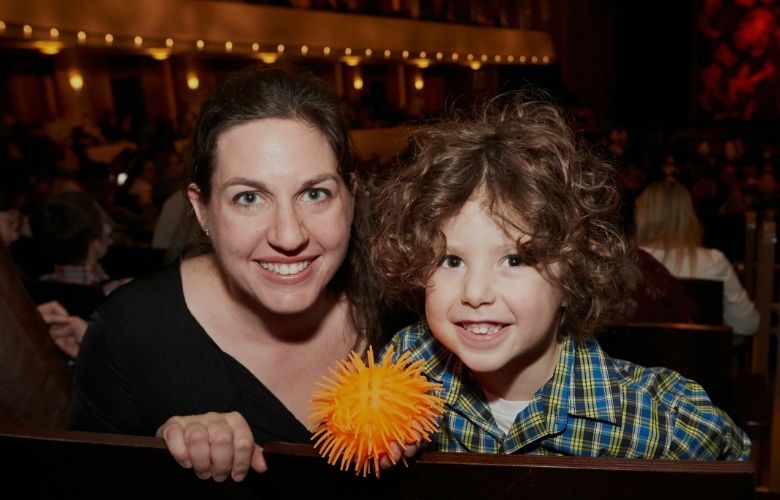
In part one we introduced what accessibility and sensory friendly shows broadly entail and discussed some of the financial elements involved with putting on performances at The Smith Center. In part two, we are joined by Melanie Jupp once again, and taking a look at the topic of engaging with sensory friendly companies.
Melanie Jupp is the Associate Director of Education and Outreach at The Smith Center for the Performing Arts and has served as project lead for The Smith Center’s sensory friendly programming, which is accomplished through the collaborative work of numerous individuals and departments of The Smith Center. Sensory friendly programming is one step presenting venues can take toward prioritising inclusion in their organisations.
TDF’s National Autism Friendly Performance Training Program was instrumental in helping us to keep on track and meet the goals we set for our first sensory friendly performances. Their Accessibility Programs department is wholly dedicated to facilitating autism friendly performances, which take place on Broadway, and they’ve spent several years refining their procedures and community connections.
The opportunity to attend one of their autism friendly performances of The Lion King on Broadway proved to be one of the most beneficial learning experiences I had throughout our entire planning process. Whenever possible, I absolutely encourage anyone considering offering sensory friendly performances to learn directly from those who are already having success in creating these opportunities.
It is in everyone’s best interest to share strategies and advice, so we can all have a common understanding and support from colleagues in other places. TDF’s National Autism Friendly Performance Training Program does this well, and the commitment they make to helping others offer autism friendly and sensory friendly performances is admirable.
With regard to the local community, we consider it imperative to dedicate your time toward creating relationships with organisations and experts serving people with disabilities in your own community. It is also advisable to foster relationships with individuals with disabilities who are interested in helping your organisation in an advisory capacity or as a member of a committee as representation of their experiences and recommendations is incredibly important.
These are necessary steps to ensure that you are receiving guidance and recommendations from people with expertise in disability.
You also gain connections to support audience development efforts. These experts have the most current knowledge of what their peers, clients, and participants need, and may also help provide opportunities to connect directly with their participants at events, on their websites, or in newsletters.
In our months of preparation before a sensory friendly performance of a touring Broadway production, we like to attend a few large community events hosted by organisations represented on our Sensory Friendly Advisory Committee.
We know many of the audience members we want to reach will also be attending these events, and we make arrangements with the organisation to either attend as a vendor to provide information about the upcoming show in person, or to share marketing materials for the organisation to distribute. Attending events in person is preferable, so you can begin to make connections and build relationships directly with your future audience members. Events hosted by community partners also provide an opportunity to observe the atmosphere they curate for their events and become familiar with any specific accommodations they offer.
Organisations that present sensory friendly performances have always been incredibly generous and supportive whenever we have reached out for guidance. In addition to attending the performance of The Lion King on Broadway, I also had the opportunity to attend the first sensory friendly performance of the touring Broadway production of Wicked, presented by the Pittsburgh Cultural Trust.
Vanessa Braun, the Director of Accessibility at the Trust, was very helpful and supportive as we developed our sensory friendly programming. Having the opportunity to learn from her and her colleagues in person at this performance was invaluable, and we continue to connect to share our respective successes or challenges as we plan for future sensory friendly engagements. In fact, this is the case with everyone we connect with to discuss sensory friendly programming, and we strive to offer the same ongoing dialogue in return.
This depends greatly on the specific community. More often, it seems to be people with disabilities, the organisations they are engaged with, and clinical professionals approaching presenting or producing companies to advocate for sensory friendly engagements in their community. That’s because these individuals and entities are acutely aware of the lack of opportunities for people with disabilities where they live.
People with disabilities and the organisations they’re involved with are very willing to embrace more opportunities which are truly accessible and inclusive.
As long as careful planning and relationship-building takes place, it will typically mean successful events for companies looking to add sensory friendly events to their programming.
Arts and culture institutions continue to navigate the pandemic, and the biggest challenge to continuing this work for presenting organisations in the immediate future will be funding.
With many venues in the United States closed as we await a safe return to live events, rebuilding our funding sources to secure large-scale sensory friendly performances will take some time. In the meantime, that will make smaller events the most likely sustainable option.
Another challenge we perceive is the varying degrees of interest from the artistic and producing side of a production. It’s encouraging to see so many companies recognising the necessity of creating work, which is more accessible for people with varying disabilities, but this kind of awareness and understanding needs to continue to grow.
The reality is that more performances designed for sensory friendly audiences means more opportunities to continue to grow an audience base and increase demand.
Many adjustments can be made to a pre-existing show on the artistic side to be more accommodating for people with intellectual and developmental disabilities. Additionally, more companies designing performances specifically with accessibility and equity in mind will help to demonstrate the need and demand. To produce work designed for people with disabilities, funding is again imperative.
Often, these performances involve smaller audience sizes in an effort to maximise the experience for audience members. For this reason, it’s crucial to align with funders who are passionate about this work, while helping them to understand that large audience sizes do not always equate with greatest impact.
Stay tuned for Accessibility At The Smith Center: Part Three in the series, coming soon.
Website: https://www.thesmithcenter.com/
Facebook: @thesmithcenter
Twitter: @SmithCenterLV
Instagram: @smithcenterlv
YouTube Channel: here
Accessibility At The Smith Center Series: Part One
James “Fitz” FitzSimmons Interview: The Boys In The Band On Netflix


Michelle is a musician and composer from the UK. She has performed across the UK and Europe and is passionate about arts education and opportunities for women and girls.
Read Full Profile© 2021 TheatreArtLife. All rights reserved.

Thank you so much for reading, but you have now reached your free article limit for this month.
Our contributors are currently writing more articles for you to enjoy.
To keep reading, all you have to do is become a subscriber and then you can read unlimited articles anytime.
Your investment will help us continue to ignite connections across the globe in live entertainment and build this community for industry professionals.